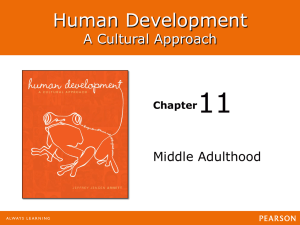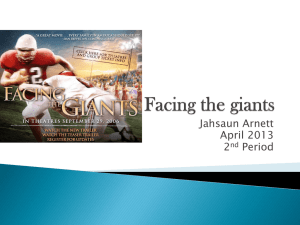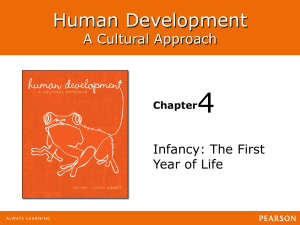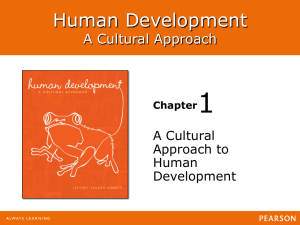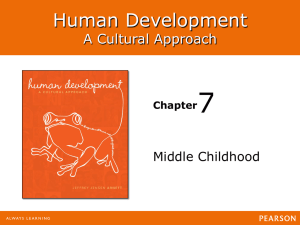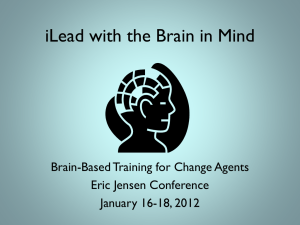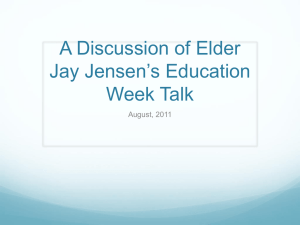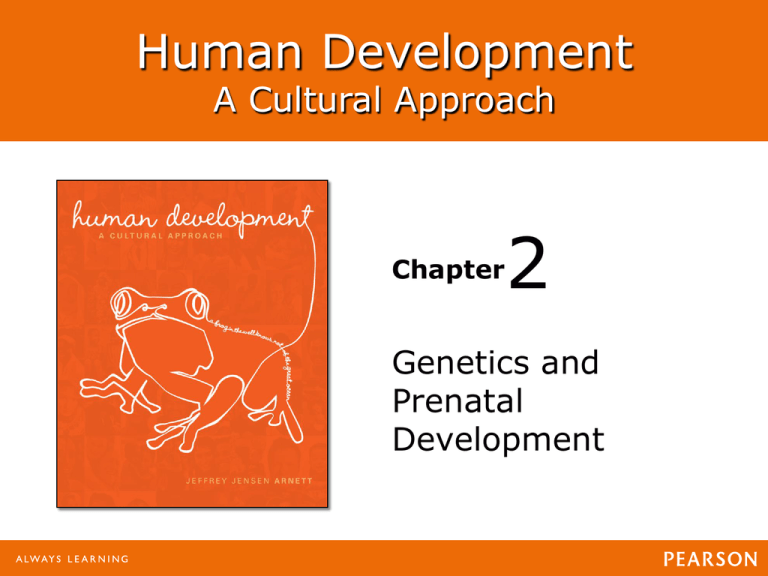
Human Development
A Cultural Approach
Chapter
2
Genetics and
Prenatal
Development
Human Development: A Cultural Approach
Jeffrey Jensen Arnett
Genetic Basics
Building Blocks of Life
•
•
•
•
Chromosomes
DNA
Genes
Genomes
Human Development: A Cultural Approach
Jeffrey Jensen Arnett
Genetic Basics
Expression of Traits
• Genotype-The totality of an individual’s
genes
• Phenotype-Actual Characteristics
This is what is seen or observed and can
include a wide range of things
Human Development: A Cultural Approach
Jeffrey Jensen Arnett
Studies of identical twins illustrate how different factors like smoking, sun exposure, depression and
weight gain can influence aging. Age 52. The twin on the left smokes and has a history of more sun
exposure, resulting in an older appearance than her twin of the same age. Photo: Dr. Bahman Guyuron
Human Development: A Cultural Approach
Jeffrey Jensen Arnett
Genetic Basics
Expression of Traits
• Dominant Genes-Expressed
characteristics
• Recessive Genes-Not expressed,
although it is a part of the genotype
(genetic background)
• Allele-Alternate form of a gene
• Dominant-Recessive Inheritance
Human Development: A Cultural Approach
Jeffrey Jensen Arnett
Table 2.1
Traits With Single-Gene Dominant–Recessive Inheritance
Human Development: A Cultural Approach
Jeffrey Jensen Arnett
Genetic Basics
Expression of Traits
• Incomplete
Dominance
Phenotype
influenced primarily
but not exclusively
by the dominant
gene
• Polygenic
Inheritance
Interaction of
multiple genes
Human Development: A Cultural Approach
Jeffrey Jensen Arnett
Genetic Basics
The Sex Chromosomes
• The 23rd
chromosomes pair
determine male or
female
• Males more
vulnerable to Xlinked recessive
disorders
Human Development: A Cultural Approach
Jeffrey Jensen Arnett
Genetic Basics
Genes and Environment
• Behavior Genetics
Estimating influence of genes and
environment on development
Utilize twins to understand importance of
genetics and tease out environment effects
Human Development: A Cultural Approach
Jeffrey Jensen Arnett
Genetic Basics
Genes and Environment
• Heritability
An estimate of the extent to which genes
are responsible for differences among
persons within a specific population
• Concordance Rates
Percentage that indicates degree of
similarity in phenotype among pairs of
family members
Human Development: A Cultural Approach
Jeffrey Jensen Arnett
The Human Experience
Conception and Prenatal
Development
Human Development: A Cultural Approach
Jeffrey Jensen Arnett
Sperm and Egg Formation
Cell Division
Human Development: A Cultural Approach
Jeffrey Jensen Arnett
The Beginning of Life
Conception
• For conception to occur there must be a
released ovum and a sperm.
• Ovulation releases the ovum, and if
sperm available, fertilization can occur.
Human Development: A Cultural Approach
Jeffrey Jensen Arnett
The Germinal Period
First 2 Weeks of Life
• During the travel from the fallopian tube to
the uterus cell division is taking place
Blastocyst
Trophoblast
Embryonic disk
Human Development: A Cultural Approach
Jeffrey Jensen Arnett
The Embryonic Period
Week 3-Week 8
• Key Developments
Embryonic Layers
-
Ectoderm
Mesoderm
Endoderm
Human Development: A Cultural Approach
Jeffrey Jensen Arnett
The Embryonic Period
Week 3-Week 8
• Key organs and structures are forming
including
Heartbeat
Eyes, nose and mouth
Bone development
Arm and leg buds
Digestive system
Human Development: A Cultural Approach
Jeffrey Jensen Arnett
The Fetal Period
Week 9-Birth
• The longest period of prenatal
development
Heartbeat can be heard
Movement can be felt
Responds to sounds
Main impediment to viability is lung
development
Human Development: A Cultural Approach
Jeffrey Jensen Arnett
The Fetal Period
Week 9-Birth
Human Development: A Cultural Approach
Jeffrey Jensen Arnett
Prenatal Care
Traditional Cultures and Beliefs
• Prenatal beliefs are impacted by
generational wisdom of the time
• These beliefs can include
Avoiding wine
Specific types of meat
Certain types of hot, cold food
Witches
Strong foods
Human Development: A Cultural Approach
Jeffrey Jensen Arnett
Prenatal Care
Science Driven Prenatal Care
• Some current science-driven prenatal
methods are derived from traditional
cultures which includes massages
• Current care can vary by ethnicity and
SES
• Developing world less likely to receive
prenatal care
• Current focus on diet, exercise, and
teratogens
Human Development: A Cultural Approach
Jeffrey Jensen Arnett
Map 2.1 Ethnic Variations in Prenatal Care within the United States How does prenatal care
differ for White women compared with other ethnic groups? What economic factors might account for
these variations?
Human Development: A Cultural Approach
Jeffrey Jensen Arnett
Prenatal Care
Diet
• Two key vitamins are iodine and iron
• Iodine deficiency tends to be a bigger
issue in developing countries
• Iron is necessary for a healthy
pregnancy
Human Development: A Cultural Approach
Jeffrey Jensen Arnett
Prenatal Care
Exercise
• Continued physical activity is
encouraged during pregnancy
• Aerobic exercise encourages good
cardiovascular health and positively
benefits the fetus
• A Non-aerobic exercise called Kegel
exercises are also encouraged
Human Development: A Cultural Approach
Jeffrey Jensen Arnett
Prenatal Care
Teratogens
• Teratogens are environmental and
bodily conditions that could be harmful
• They can include tobacco, alcohol,
prescription medications and other
drugs
• The physical environment could also be
a teratogen due to malnutrition or
exposure to hazardous chemicals
Human Development: A Cultural Approach
Jeffrey Jensen Arnett
Safety sign. Source: http://www.compliancesigns.com
Human Development: A Cultural Approach
Jeffrey Jensen Arnett
Pregnancy Problems
Human Development: A Cultural Approach
Jeffrey Jensen Arnett
Chromosomal Disorders
• Chromosomal disorders can occur
because of an issue during meiosis
This may cause too many or too few
chromosomes in the cells of the zygote
• Two types of chromosomal disorders
are:
Sex chromosome disorders
Disorder on the 21st chromosome (Down
Syndrome)
Human Development: A Cultural Approach
Jeffrey Jensen Arnett
Sex Chromosome Disorders
• Sex chromosomal disorder can result
from extra X, an extra Y, or only an X
and no second chromosome
Common consequences of sex
chromosome disorders include:
- Cognitive Deficit
- Abnormality in reproductive system at
puberty
Human Development: A Cultural Approach
Jeffrey Jensen Arnett
Down Syndrome
Trisomy 21
• Identifiable by physical characteristics
• Cognitive Deficits
Speech problems
Mental retardation
• Social development varies
• Lower life expectancy
Human Development: A Cultural Approach
Jeffrey Jensen Arnett
Parental Age and Chromosomal
Disorder
• Chromosomal disorders tend to NOT be
passed from parent to child
• Relationship between maternal age and
chromosomal disorders
• There may be a relationship between a
father’s age and chromosomal
disorders but it isn’t as clear
Human Development: A Cultural Approach
Jeffrey Jensen Arnett
Figure 2.7
Chromosomal Disorders and Maternal Age Why does the risk rise so steeply after age
40? Source: Reproductive Medicine Associates of New Jersey, 2002
Human Development: A Cultural Approach
Jeffrey Jensen Arnett
Teratogens
• Major teratogens exist in both
developed and developing countries
Malnutrition
Infectious Disease
Alcohol
Tobacco
Human Development: A Cultural Approach
Jeffrey Jensen Arnett
Teratogens
Timing of Teratogens
• Teratogens can impact the developing
fetus and embryo at any time
• There does appear to be a critical
period of prenatal development
centered in the embryonic period
Human Development: A Cultural Approach
Jeffrey Jensen Arnett
Teratogens
Timing of Teratogens
Human Development: A Cultural Approach
Jeffrey Jensen Arnett
Teratogens
Malnutrition
• Rural nature of half the world’s
population impacts nutrition
• Children’s health could vary based on
country or area of conception
Human Development: A Cultural Approach
Jeffrey Jensen Arnett
Teratogens
Malnutrition
• Developed countries have food
available but may have malnutrition
• May be deficient in specific vitamins or
improper diet may lead to obesity
Maternal obesity is linked to baby
complications
• Prenatal nutrition can also cause
prenatal problems
Human Development: A Cultural Approach
Jeffrey Jensen Arnett
Teratogens
Infectious Diseases
• Rubella (German Measles)
Exposure during embryonic stage can lead
to heart abnormalities and mental
retardation
Exposure during the fetal stage can lead to
hearing problems and low birth weight
• Vaccination can help but Rubella
remains widespread in less developed
countries
Human Development: A Cultural Approach
Jeffrey Jensen Arnett
Teratogens
Infectious Diseases
• AIDS (Acquired Immune Deficiency
Syndrome)
• Three strategies can help prevent
transmission
Effective medicines
Cesarean sections for AIDS-infected moms
Infant formula in place of breast feeding
Human Development: A Cultural Approach
Jeffrey Jensen Arnett
Teratogens
Drugs-Alcohol
• Widespread damage in developed
countries
• Fetal Alcohol Spectrum Disorder
• Increased effects as child develops
Human Development: A Cultural Approach
Jeffrey Jensen Arnett
Teratogens
Drugs-Tobacco
• Maternal smoking increases risk of
miscarriages, premature birth and low
birth weight
• Infant effects include difficulty
breathing and impaired heart
functioning
Human Development: A Cultural Approach
Jeffrey Jensen Arnett
Teratogens
Drugs-Tobacco
• Childhood effects include poorer
language skills, attention and memory
problems and behavior problems
• Second hand smoke by fathers is also
detrimental
Human Development: A Cultural Approach
Jeffrey Jensen Arnett
Teratogens
Drugs
• Malnutrition and diseases are common
in developing countries
• Alcohol and tobacco are common in
developed countries
• Prescription drugs can be damaging
• Other teratogens include nonprescription drugs, severe stress,
pollution and radiation
Human Development: A Cultural Approach
Jeffrey Jensen Arnett
Prenatal Diagnosis
• Ultrasounds-Uses high frequency sound
waves
• Amniocentesis-Utilizes amniotic fluid
• Chorionic Villus Sampling-Utilizes cells
from forming umbilical cord
Human Development: A Cultural Approach
Jeffrey Jensen Arnett
Infertility
Causes
• For men three main causes
Too few sperm
Quality of sperm
Low motility
• For women many causes
One is ovulation
Human Development: A Cultural Approach
Jeffrey Jensen Arnett
Figure 2.9
Fertility and Maternal Age Why does fertility decline after the mid-twenties?
Source: Reproductive Medicine Associates of New Jersey, 2002
Human Development: A Cultural Approach
Jeffrey Jensen Arnett
Infertility
Treatments
• Historical treatments of infertility
included:
Giving more attention to wife to achieve
mutual orgasm
Surgery on a woman’s anatomy
Bloodletting
• Current treatments are more advanced
Human Development: A Cultural Approach
Jeffrey Jensen Arnett
Infertility
Treatments
• Many treatments utilize Assisted
Reproductive Technologies (ART)
Artificial Insemination
- Injects sperm into woman’s uterus
Fertility Drugs
- Mimic hormones involved in ovulation
In-vitro fertilization
- Ova removed and fertilized outside the
womb then placed into uterus
Human Development: A Cultural Approach
Jeffrey Jensen Arnett
Map 2.2 The “Infertility Belt” In certain countries in Central Africa, infertility rates are as high as
30%. The reasons for this are unclear although malnutrition and high rates of STIs are probable factors.
Human Development: A Cultural Approach
Jeffrey Jensen Arnett

